MyGlue Scenario 4 - Collaboration
If you'd like to know more on how to deploy MyGlue, please view MyGlue Deployment Guide.
Scenario Purpose
Deploy MyGlue account for key stakeholders at client’s organization that provides them with access to some or all assets and data in IT Glue.
Scenario
Building stickiness with clients is the key to maintaining a healthy and profitable relationship. With MyGlue, you can securely collaborate with your clients’ key stakeholders by sharing what you have documented in IT Glue, and giving them the ability to add and modify information to give you more visibility into their IT environment. Collaboration enables a two-way flow of information.
In this scenario, you will deploy MyGlue, then share workstation configurations you have documented in IT Glue with the client, so the client’s stakeholder can update the assigned contact when new employees join or leave the company.
MyGlue Deployment Steps
- Navigate to Account > MyGlue and click + New.

If you have never set up a MyGlue account before, you will see the screenshot below when you click MyGlue from the sidebar.

- If this is the first MyGlue account you are setting up, you will be prompted to enter support information. If not, please skip this step.
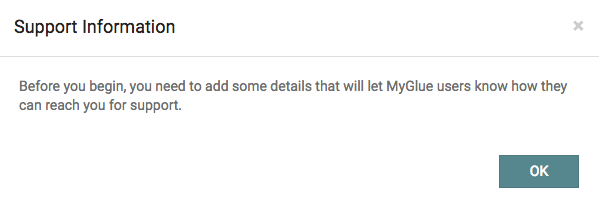

- In the New Account page, complete the following:
- Enter a name for the new MyGlue account.
- Choose the existing IT Glue Organizations you’d like to assign.
- If you want to enforce MFA for the account, check Require MFA for access to this MyGlue account. Refer to our KB article here for details on prerequisites needed for this setting.
- Select a global default security permission for the account. There are three options:
- All MyGlue users with access to the organization have access by default - Passwords created by MyGlue users will be visible to all other MyGlue users with access to the same organization. This ensures that a low-risk and widely used password is easily accessible.
- Only the creator has access by default - Passwords created by MyGlue users are visible only to that user. This ensures that a password is not exposed to an entire group or organization upon creation.
- Specific groups and/or users with access to the organization can access by default - Passwords created by MyGlue users will be automatically shared to specifically chosen MyGlue groups/users or IT Glue groups. This means that MyGlue users don’t need to remember to set those permissions each time they create a password. The password creator will still have access.
Note: It is a pre-requisite that specific IT Glue groups should have been already created to use this option. If not, the list of IT Glue groups will not be listed under this option. You will be able to create and add MyGlue groups to the MyGlue account only after you create the MyGlue account.
- Click Save.
- You will be prompted to create MyGlue Groups as MyGlue groups are required to create MyGlue users. Click OK.

- Create a security group for this MyGlue account. Enter a name and an optional description for the group, and add all MyGlue users who should have access to the group. If you do not yet have MyGlue users in IT Glue, you can invite them on the next screen. You can also add additional organizations here.
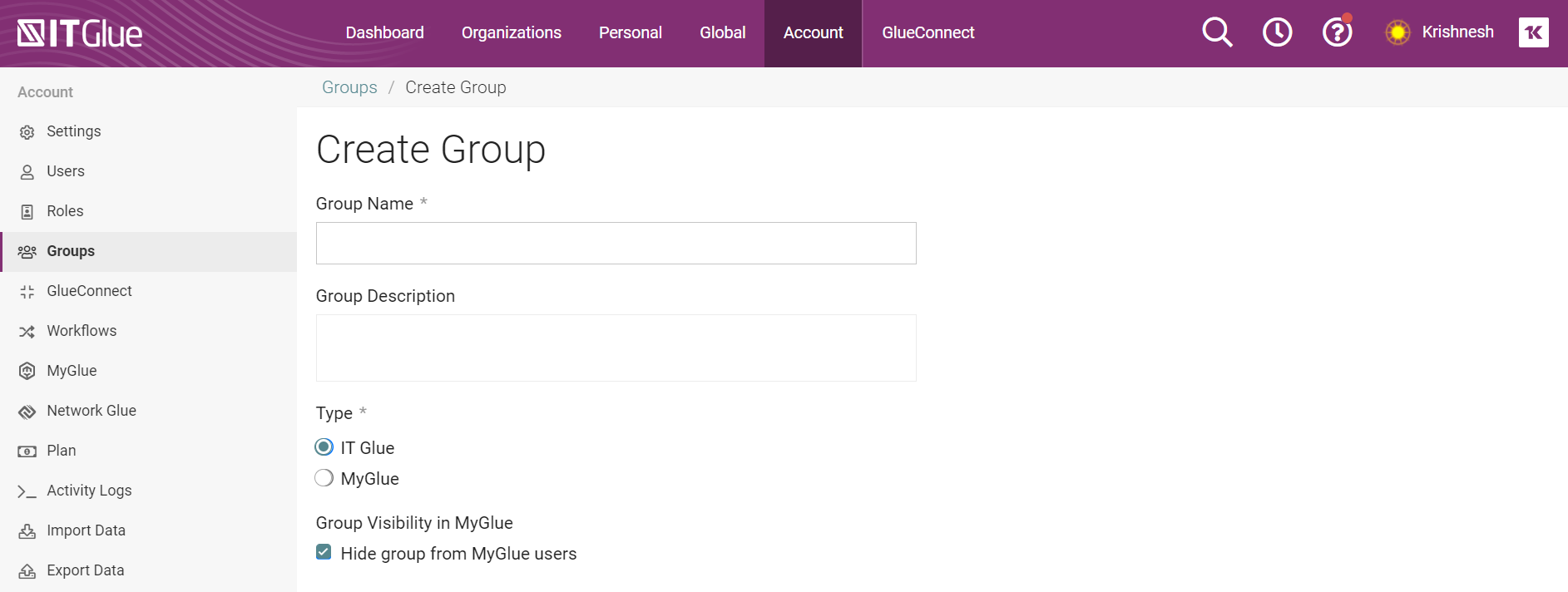
- Uncheck Grant access to unrestricted ("All IT Glue Users") IT Glue data within the allowed Organizations to restrict asset access to the MyGlue Users / Groups you specify.

- All asset types will be checked to deny access by default. Since in this scenario, you are sharing documented Configurations and Contacts, uncheck these and click Save.
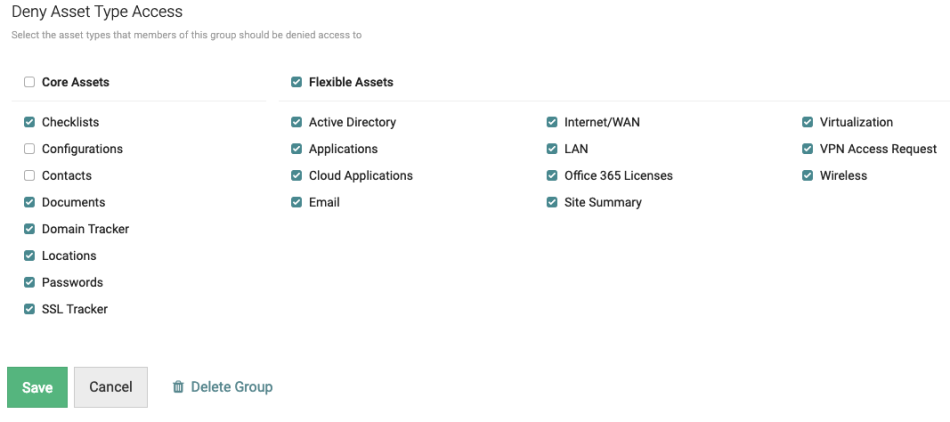
- Uncheck the organization's contacts you do not want to invite to MyGlue, and click Next.

- Set the appropriate permissions for the invited users. Our MyGlue user roles, groups, and permissions KB article will help you decide which role to give the users. Click Save.

Share workstation configurations with MyGlue users
You may have multiple configurations documented for your client, but you only want to share their current, active Workstations and Laptops that are deployed at their site with them.
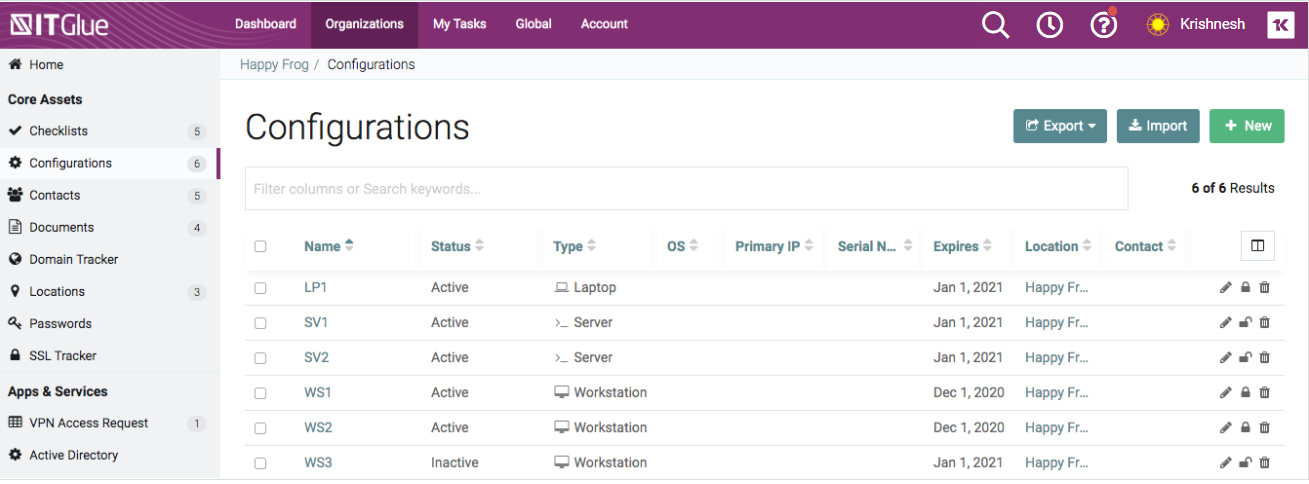
Let's assume that in the screenshot above, LP1, WS1 and WS2 are deployed at your client's site and you want to share these assets with your client.
- Click the pencil icon next to the Laptop LP1 to edit the configuration.

- On the edit screen, scroll down to Security, click Specific Groups and/or Users can access this Configuration.

- Click the dropdown next to MyGlue groups and add the group you created for your MyGlue account. Click Save.
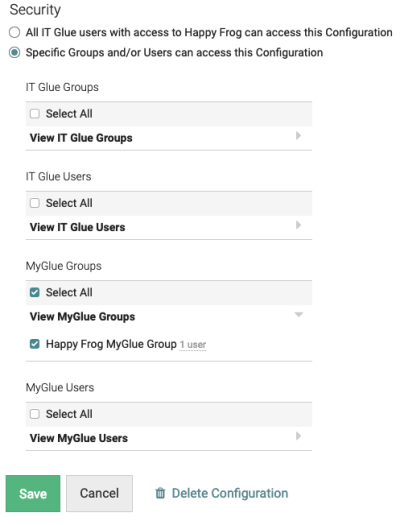
NOTE You can also add individual MyGlue users using the MyGlue Users option, or you can create additional MyGlue groups to allow certain groups of MyGlue users at your client site to access the assets.
MyGlue Users
Your MyGlue users will only see Configurations and Contacts in their sidebar and will see the list of contacts and configurations you have explicitly given them access to. Notice that SV1, SV2 and WS3 are not in the list.
They can edit any configuration they see here and assign a new contact to it when employees leave or join the company.
Back within IT Glue, you will see these changes immediately.
NOTE This process requires the use of an IT Glue user group so you will need to make that group visible in the security permission settings. This allows the group to be visible in the security permissions settings in MyGlue. To do this:
- Navigate to Account > Groups within IT Glue.
- Locate the MyGlue security group you created and click on the pencil icon to edit it.
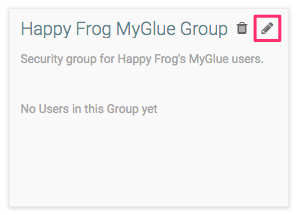
- Uncheck the Hide group from MyGlue users checkbox.
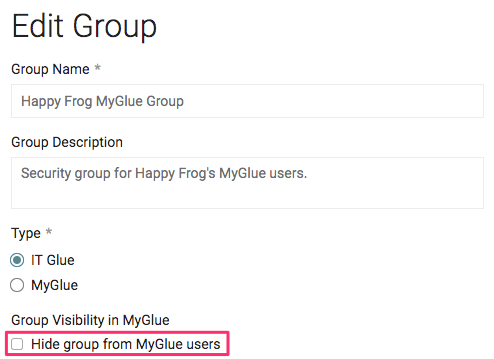
Additional Use Cases
The above is just one example of how IT Glue and MyGlue can be used to collaborate with your clients. Other examples of utilizing MyGlue as a collaborative tool include:
- Sharing an onboarding checklist with the client and specifying the tasks you are responsible for, and the tasks the client is responsible for. This way, both parties have the visibility they need to ensure a smooth onboarding process.
- Creating an “Onboarding” Flexible Asset for any newly onboarded clients. It has all the fields and information you require to get them started. You can share the flexible asset with the client to complete the required information in MyGlue, which they then share with you. This way, all the information is automatically logged in IT Glue.
- Sharing the Licensing Flexible Asset in IT Glue with your client so they can assign purchased licenses to the the relevant contact / asset.
- Creating a “Disaster Recovery Plan” Flexible Asset and sharing it with your client through MyGlue so they can easily update information to keep the Disaster Recovery procedure up-to-date. This will ensure that if a disaster does happen, both parties have the most up-to-date information to quickly resolve the situation.
Please also see the below scenarios for other ways you can utilize MyGlue.



